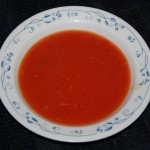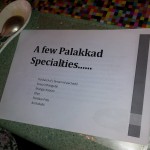Meet Sandhya Oza, a smart, young model, mother of two, who is pursuing her passion for cooking by running Indian cookery classes called Curry Classes. She started Curry Classes when she lived in England to teach the locals healthy Indian style cooking. She was interviewed on BBC Essex Radio. After moving to Bangalore, she continues to teach simple and easy cooking from scratch, using only farm fresh produce and chicken. Curry Classes are run in Whitefield, Bangalore. Do get in touch with her at www.curryclasses.com
Sandhya shares one of her Curry Classes recipes with us –
Vegetable Ginger Soup (serves 1)
One big bowl of vegetables of your choice. I put tomato, dudhi (bottle gourd), carrot, onion, ginger and pepper. 2 whistles in a cooker and blitz it. Salt to taste and 1/4 teaspoon of sugar, blitz it and boil again. You can add garlic too if you wish. 
Soon after I wrote a piece last week on Manipuris’ rice eating habits, a reader sent me an email on rice, titled “Rice was never meant for human consumption”. It went on to say how cavemen ate everything raw (fruits, veggies, nuts, meat), that they did not eat rice, wheat and other grains because they didn’t cook, that rice converts into sugar, white rice has no fiber, one can overeat rice but not fruits & veggies, rice is difficult to digest, and so on and so forth.
Some of the information in this email is true but not all of it. So, here’s busting the myths on rice and stating facts nutritionally –
- Rice is meant for human consumption but not compulsory in everyone’s diet.
- There’s a huge difference between a caveman and a modern day town dweller. If we need to follow the caveman’s food habits, we also need to follow the rest of their lifestyle!
- Rice, like all other carbohydrates, ultimately gets broken down into glucose. There’s nothing wrong with this biochemical cycle since glucose is needed for our daily energy.
- White rice has very little fiber but brown rice has more fiber and also more vitamins.
- Rice is not difficult to digest. Enzymes secreted in the human digestive tract are capable of digesting rice as well as other food groups.
- It’s good to reduce the intake of starchy items like rice, wheat, etc, and increase the intake of fruits, vegetables, sprouts, etc, especially if you’re watching your weight.
The bottom line is rice is not harmful when eaten the right way and in the right amounts. 
I was so thrilled when my good friend Usha invited me over to her beautiful home to meet Madhur Jaffrey. Usha was going to showcase some Palakkad dishes to Madhur, and I was a part of the small group of friends who had the privilege of meeting and eating with the famous actress and celebrity chef, Madhur Jaffrey. What followed was a lively demonstration of the dishes by Usha, with the rest of us learning, mingling and chatting. We were treated to a delicious, fresh, home-cooked, comforting meal which all of us slurped our way through.
I’m sharing one of the recipes that Usha made –
Pulikatchal (tamarind pachadi)
Ingredients –
Tamarind – size of a golf ball
Green chillies – 5 or 6, chopped
Turmeric powder – 1/2 tsp
Sesame (til) oil – 3 tsp
Ginger – 1 inch piece, chopped fine
Sesame seeds – 1 tbsp
Jaggery powder – 1 tbsp
Mustard seeds – 1 tsp
Orange peel – 1/2 cup, chopped
Raw rice – 1 tsp
Salt to taste
Method of preparation –
Soak the tamarind in hot water and extract the pulp. Roast the rice and sesame seeds till it lets out an aroma, and powder the mixture. Heat oil, add mustard seeds, green chillies, turmeric and chopped ginger. Sauté and add the orange peel. Add the tamarind pulp, cook till the pulp thickens a bit. Add salt to taste. Add the sesame and rice powder, jaggery and allow it to simmer for about 5 minutes.
 During a recent visit to Coimbatore for a lecture, I met 2 students who belong to a tribe in Manipur. An interesting discussion on their food habits followed. Their staple is rice. They also eat fish everyday. Their diet includes lots of greens which are not commonly grown in other parts of India. Other vegetables, fruits and meat form a part of their regular meals. They do not take much dairy foods, but eat fermented fish, soy and bamboo shoots. The students said that although they enjoy the south Indian meals, on weekends they prepare some of their traditional dishes. Here’s the best part – they eat rice regularly but they are not fat! My cliched statement – Rice is not fattening!
During a recent visit to Coimbatore for a lecture, I met 2 students who belong to a tribe in Manipur. An interesting discussion on their food habits followed. Their staple is rice. They also eat fish everyday. Their diet includes lots of greens which are not commonly grown in other parts of India. Other vegetables, fruits and meat form a part of their regular meals. They do not take much dairy foods, but eat fermented fish, soy and bamboo shoots. The students said that although they enjoy the south Indian meals, on weekends they prepare some of their traditional dishes. Here’s the best part – they eat rice regularly but they are not fat! My cliched statement – Rice is not fattening!
A few weeks ago, during my consulting session, I came across a person who ate aloo (potato) as a vegetable accompaniment almost everyday in his meal. When asked why, he said that he had no idea what other vegetables he could eat and his cook didn’t know to prepare any other vegetable dish. It seemed to me that he had never seen a vegetable market in his life! When I mentioned about the need for using other vegetables in his daily diet, he said “But I’m not fat, so why can’t I eat aloo everyday? I love it.”
Hmmm. After some explanation, he agreed to try out other vegetables. But the idea that aloo needs to be eaten only if you’re slim is so not true. Aloo has gained a bad name because potato chips, French fries, aloo bonda and aloo bhajia are deep fried and are loaded with fat & calories. But the humble aloo when eaten boiled, steamed or in the form of a sabji, sambar, raita, contains very little fat unless you douse it with butter / oil. Aloo can be eaten by slim as well as not so slim people provided it’s cooked in a healthy manner.
Share your ‘aloo’ experiences, if you wish. 



